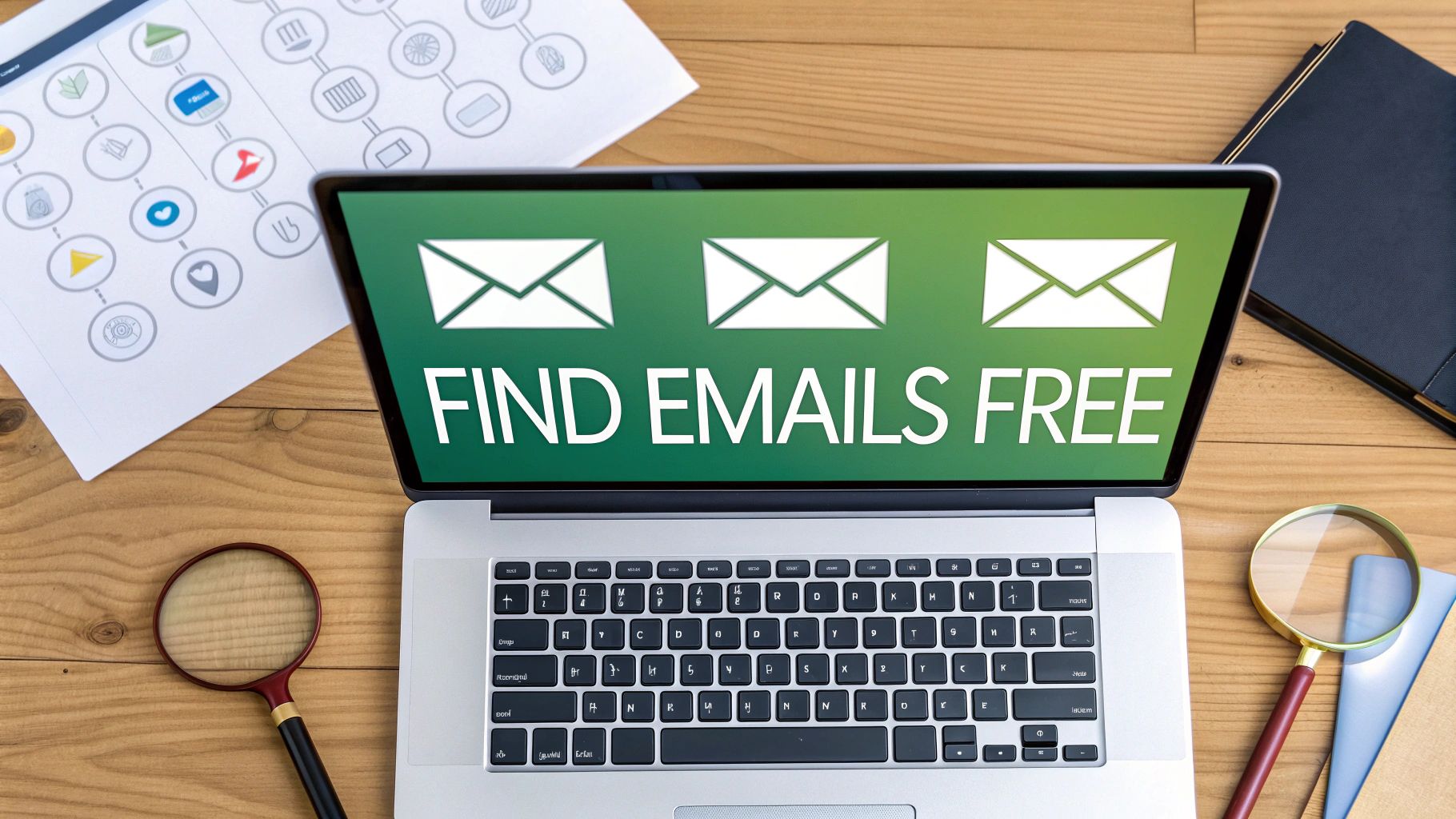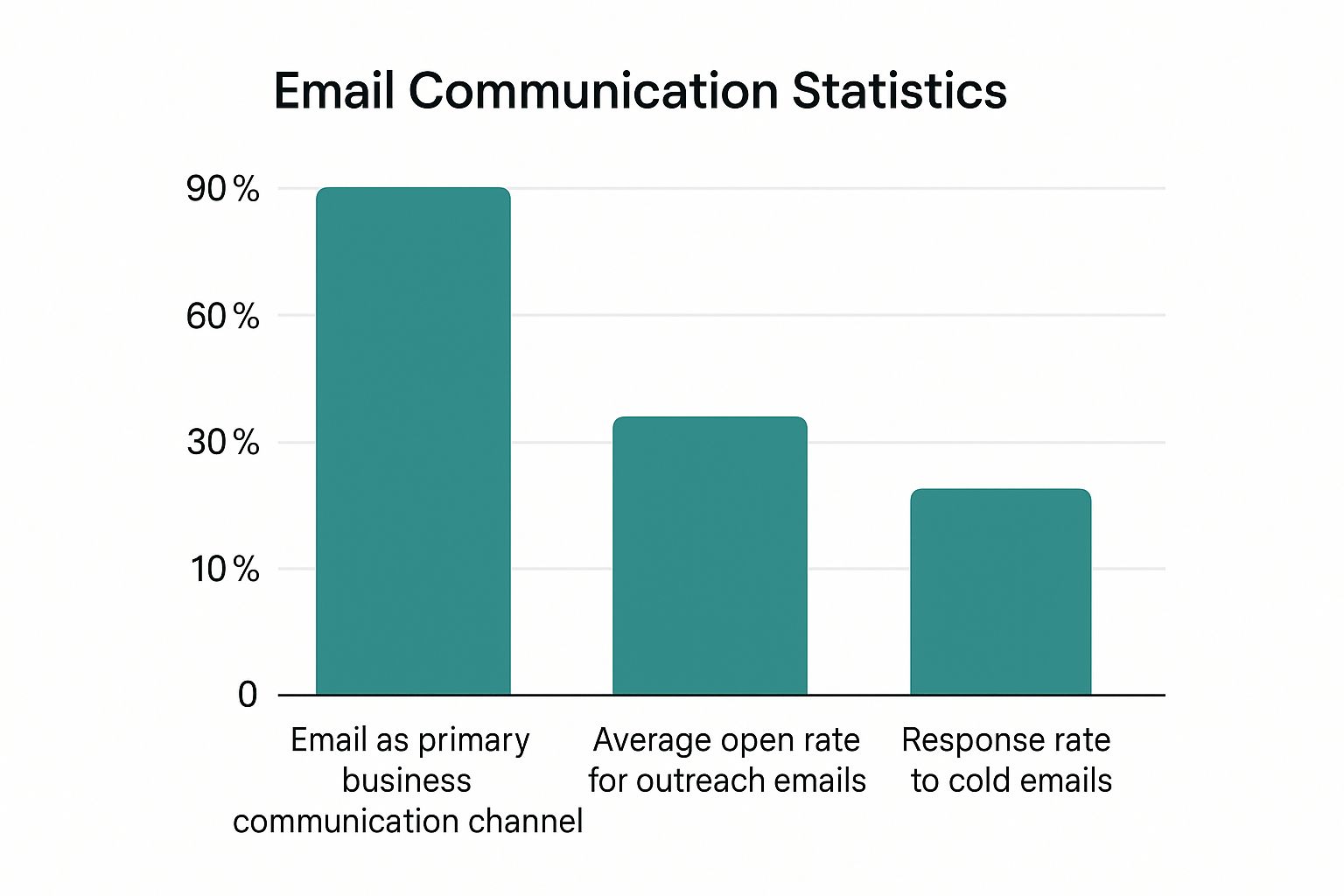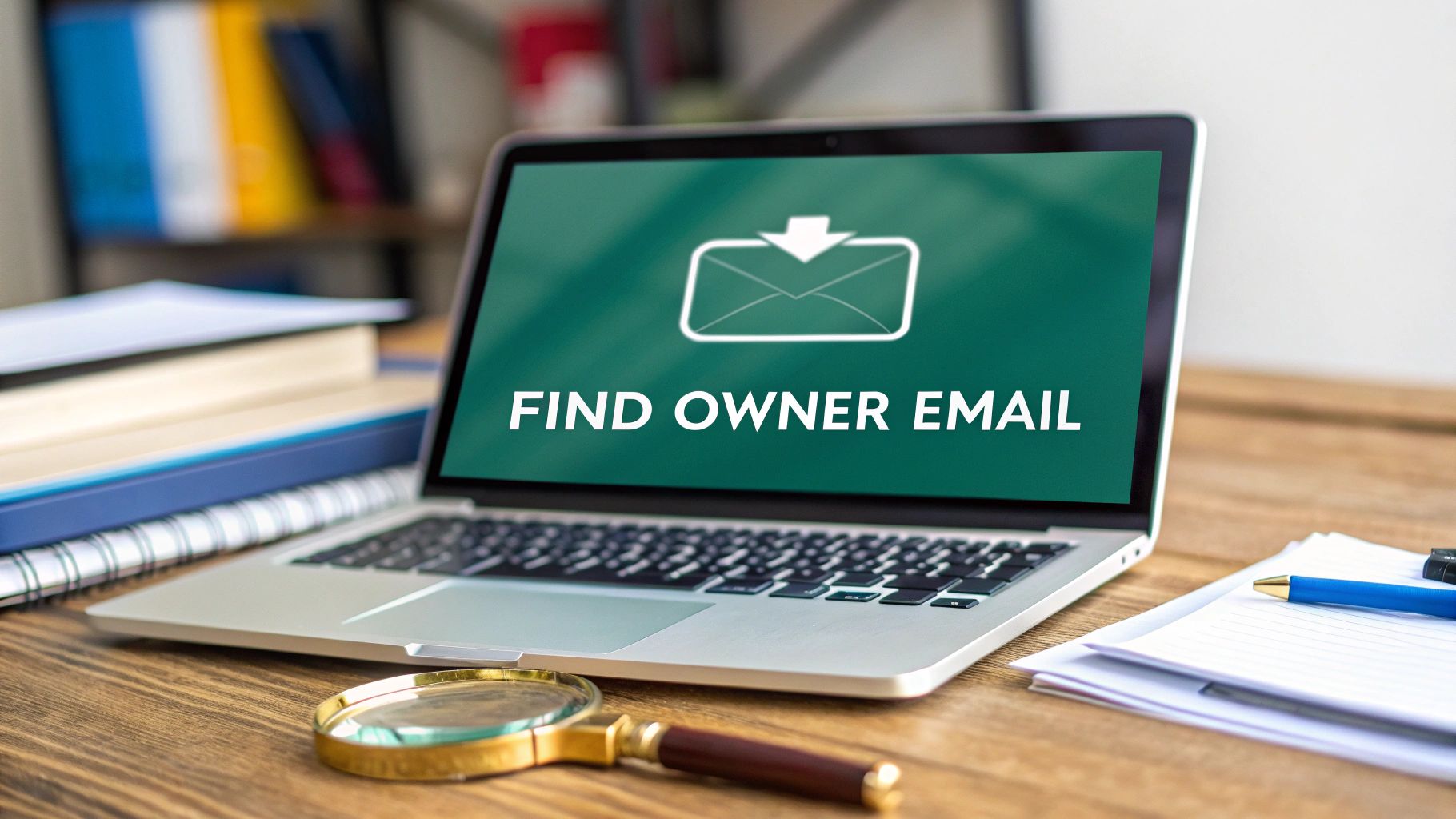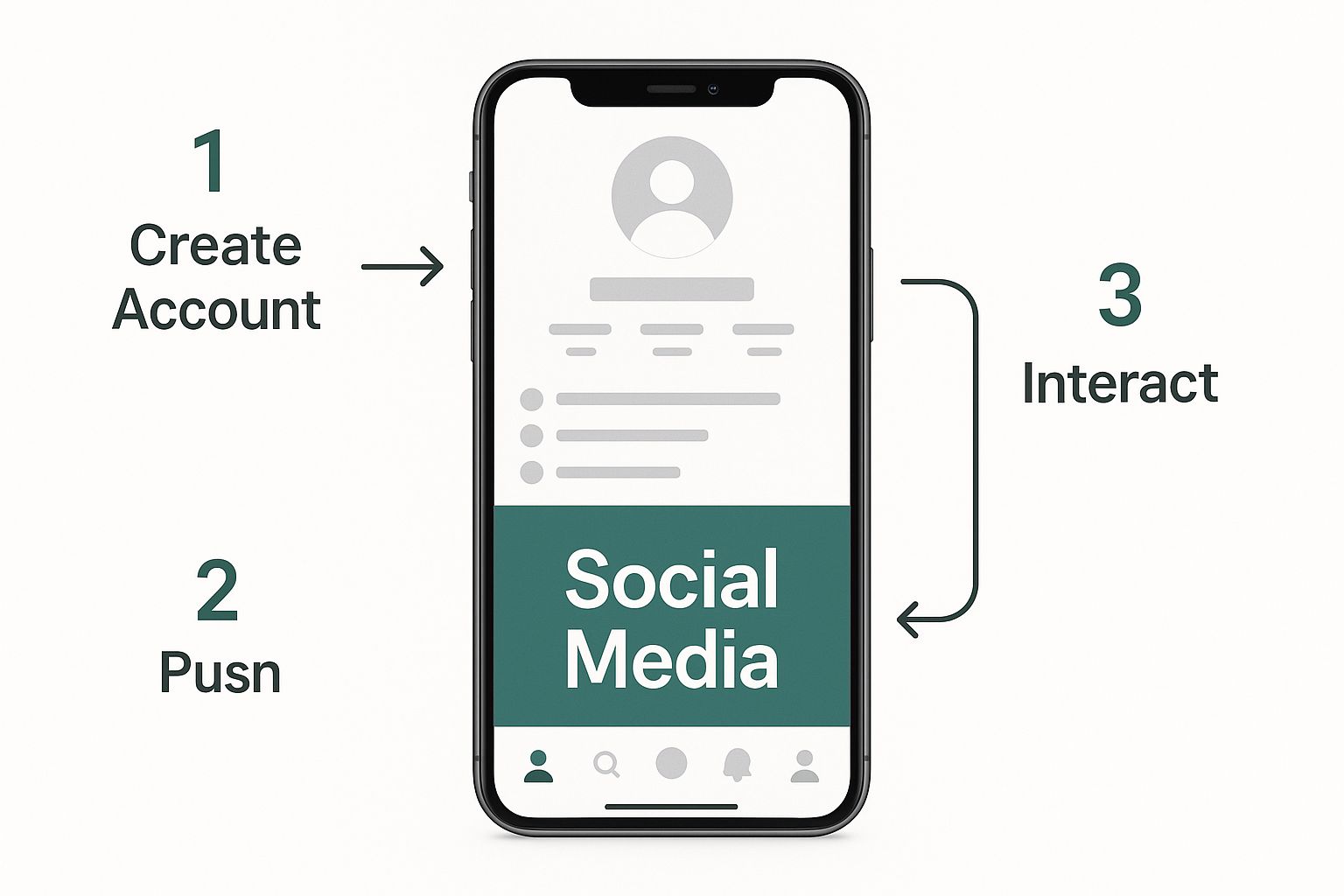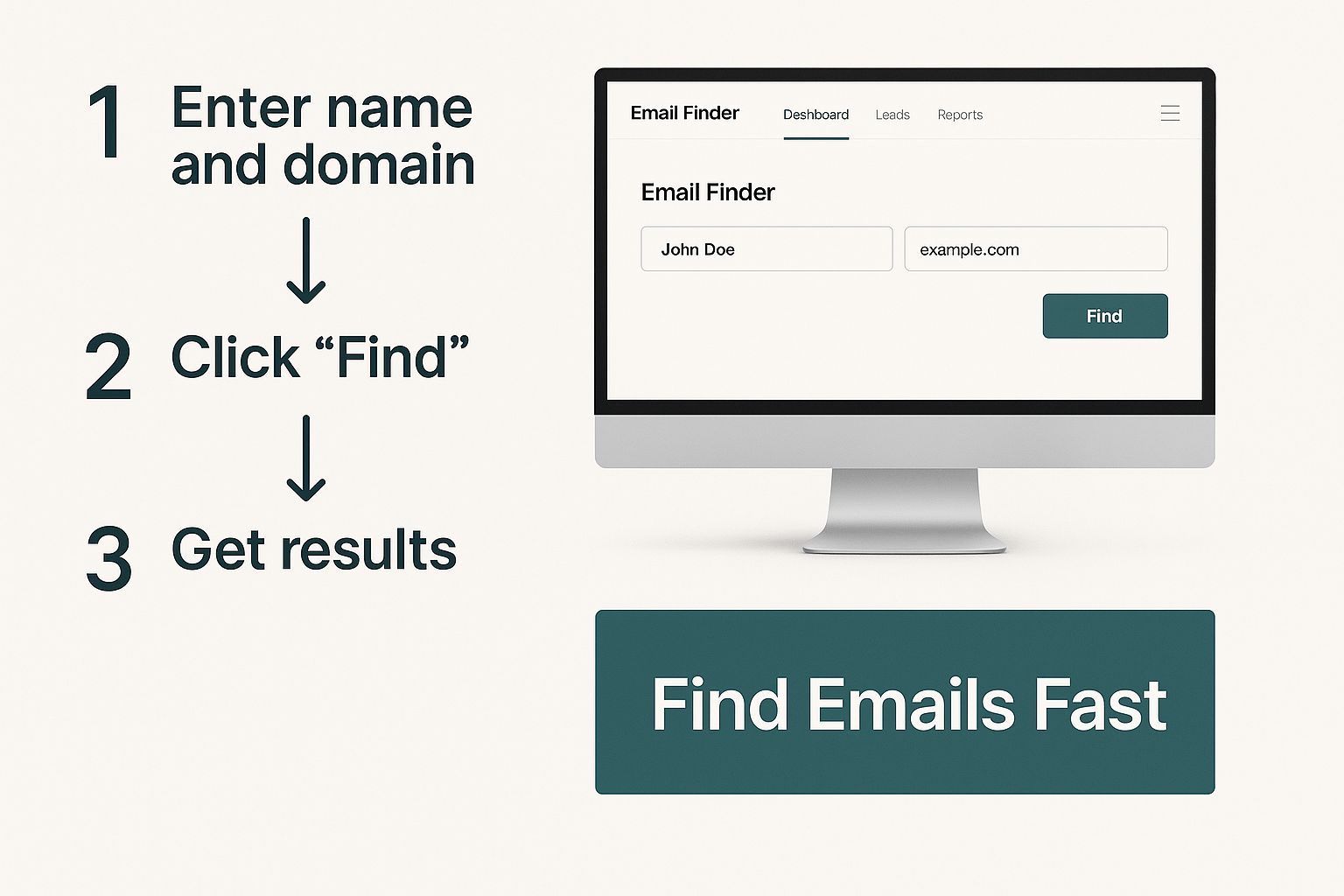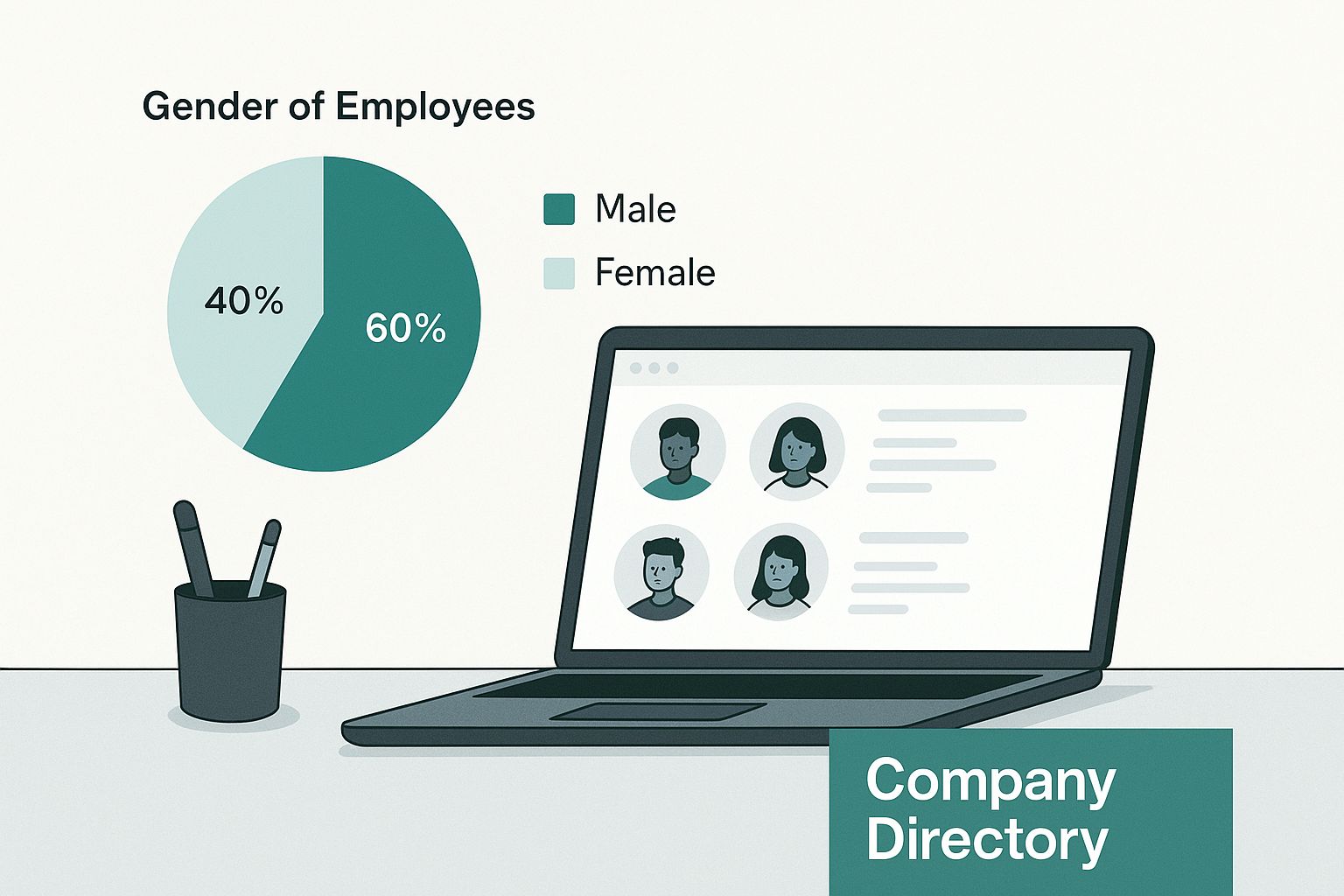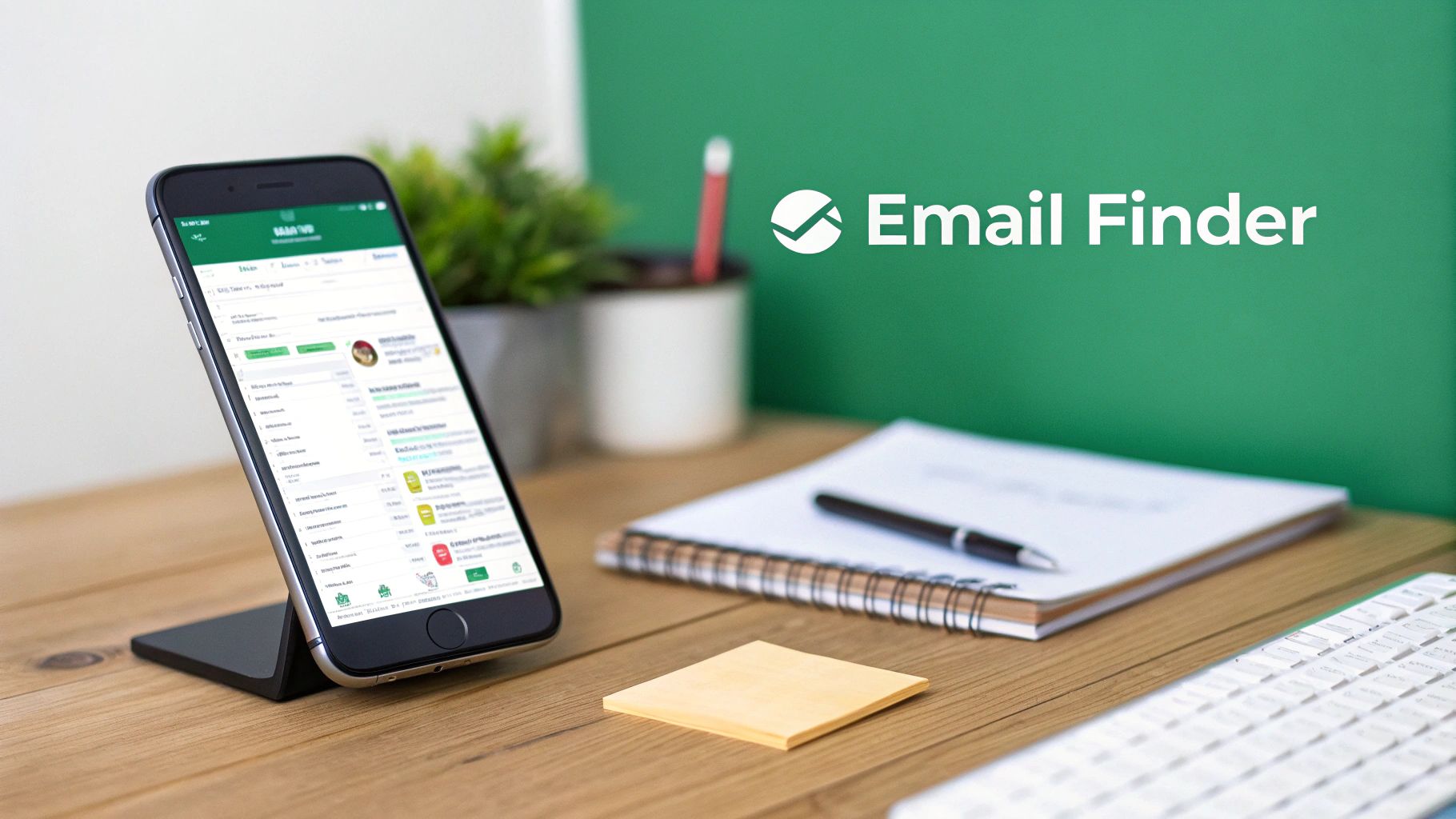You might think finding someone's email is like searching for a needle in a haystack. It's actually a lot simpler than you'd imagine. The most reliable ways usually involve using a dedicated email finder tool, doing a quick scan of social media profiles (especially LinkedIn), or even just taking an educated guess based on common company email patterns.
Why Finding the Right Email Is Still a Game Changer

Before we jump into the "how," let's talk about the "why." In a world drowning in social media noise and chatbot pop-ups, a direct email is like a professional hotline. It cuts right through the digital clutter and opens a direct line for a real conversation.
For anyone in sales, marketing, recruitment, or business development, knowing how to find a specific email is a legitimate superpower. Think about it. That LinkedIn InMail you sent to a key decision-maker might be sitting unread, but a sharp, well-written email in their primary inbox? That gets attention.
The Power of a Direct Connection
This isn't just about blasting messages into the void; it's about creating opportunities.
I've seen it firsthand. Finding the direct email of a conference organizer can be the one thing that gets you a speaking slot instead of getting lost in a generic submission form. A salesperson who can track down the VP of Procurement’s direct email has a massive leg up on competitors who are still sending pitches to "info@" addresses.
A direct email shows a few key things:
- Professionalism: It proves you’ve done your research and are serious about connecting.
- Respect: You’re reaching out on their turf, a channel they control, not a public forum.
- Efficiency: It’s simply the fastest way to get an idea, a question, or an introduction in front of the right pair of eyes.
The ability to find a specific email address transforms your outreach from a shot in the dark to a targeted, strategic action. It’s the foundational skill for building professional relationships that drive results.
And email isn't going anywhere. The numbers are staggering. Global email traffic is projected to grow from 392 billion emails sent per day in 2025 to a mind-boggling 523 billion by 2030. It's still the absolute cornerstone of professional communication. If you want to dive deeper, you can read more about these email usage trends to see why mastering these search skills is so critical.
7. Master the Art of Manual Searching
Before you pull out your credit card for a fancy tool, it's worth putting on your digital detective hat. You'd be amazed at how often you can find someone's email with just a bit of clever searching and educated guesswork. It really just comes down to knowing where to look and what patterns to spot.
A lot of companies use a standard format for their employee emails, which makes them surprisingly predictable. If you have the person's first and last name plus their company's domain (like company.com), you're already most of the way there. All you need to do is test a few of the most common combinations.
Crack the Code of Common Email Patterns
I always start by jotting down a list of potential email addresses based on the usual corporate structures. This simple trick works more often than you'd think, especially with small to mid-sized companies that don't overcomplicate their email conventions. Once you have a handful of solid guesses, the next step is to verify them.
This table covers the most common business email patterns I've run into over the years. Keep it handy as a quick reference.
Common Business Email Address Patterns
| Pattern Example | Format | Likelihood of Use |
|---|---|---|
| john.smith@company.com | firstname.lastname |
Very High |
| jsmith@company.com | firstinitial.lastname |
Very High |
| john@company.com | firstname |
High |
| johns@company.com | firstname.lastinitial |
Medium |
| smith.john@company.com | lastname.firstname |
Medium |
Just remember, while these patterns are common, some companies use unique formats. But starting here gives you a massive head start.
For a more detailed breakdown, our guide on how to find an email from a website dives even deeper into uncovering company-wide email patterns.
Think Beyond the Obvious Search
Your hunt shouldn't end with just pattern-guessing. Most professionals leave a trail of digital breadcrumbs all over the web that can lead you straight to their inbox. You just have to think about where they'd be most likely to share their professional contact details.
Here are a few goldmines that people often overlook:
- Company 'About Us' Pages: This is a classic. Senior leaders or department heads are often listed right here with their direct contact info.
- Blog Author Bios: Has your contact written for their company blog or an industry publication? Check the bio at the bottom of the article. It's a common spot for an email address.
- Personal Websites or Portfolios: Creatives, consultants, and many executives run their own personal sites. A "Contact Me" page is practically a given and your most direct route to their inbox.
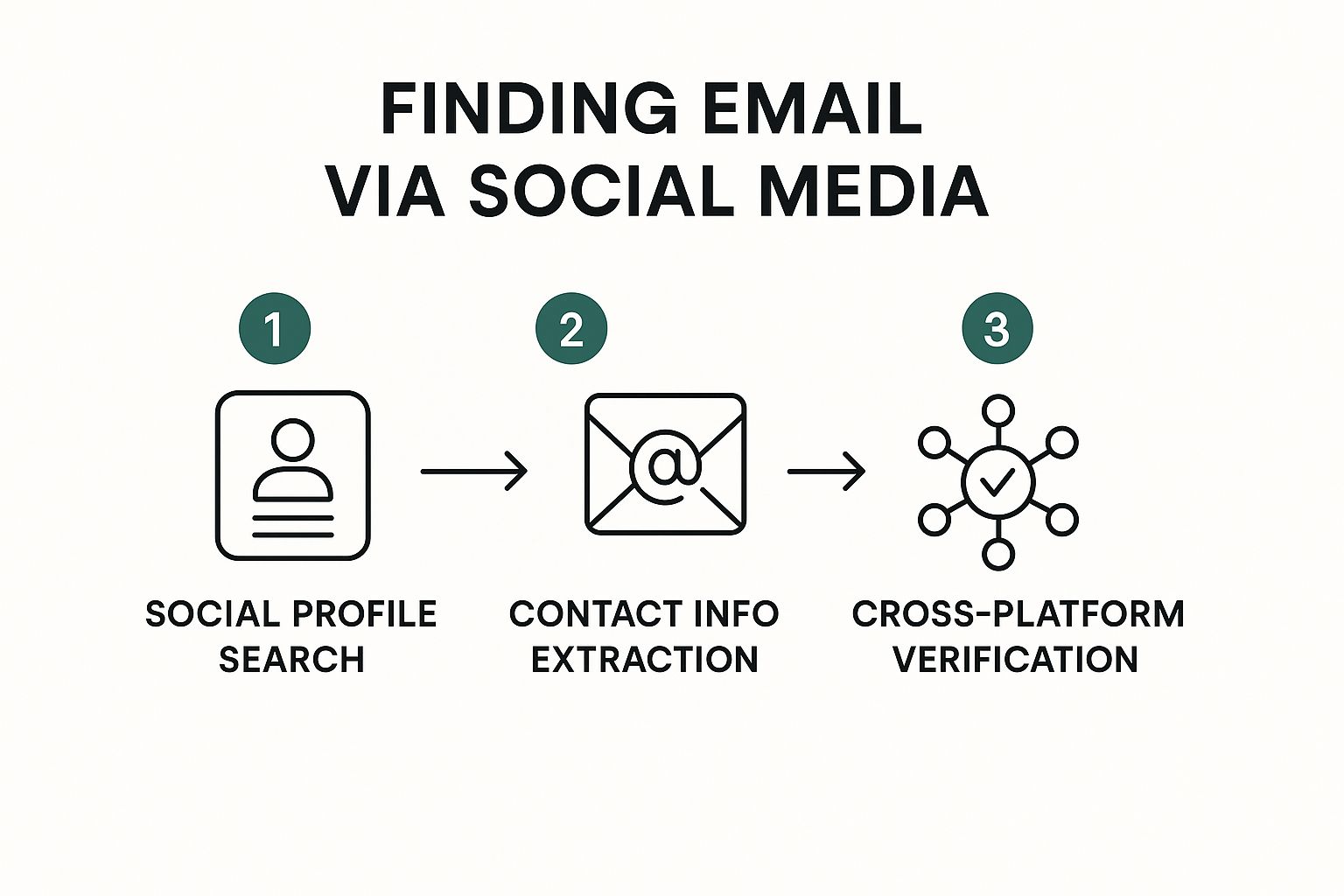
LinkedIn is another fantastic resource, but don't just look at the contact info section. Sift through their activity feed. Have they ever dropped their email in a comment? Also, check their "About" summary—many people put their preferred contact method there for professional inquiries.
When you combine these manual techniques, you create a powerful, no-cost way to find just about anyone's email. Sure, it takes a bit more legwork than an automated tool, but the satisfaction of unearthing that hard-to-find address makes it a skill worth mastering. Just be methodical, check your findings, and always verify an address before you hit send.
Using Email Finder Tools to Work Smarter

When your manual detective work hits a wall, it’s time to bring in the technology. Email finder tools are specifically designed to automate the search process, saving you hours of guesswork and pulling verified contact information in just a few seconds.
Let’s be honest, these tools aren't just a convenience—they're a necessity for anyone serious about outreach at scale. With around 376.4 billion emails expected to fly around the internet daily by 2025, finding one specific address is like trying to find a particular grain of sand on a beach. Automated tools are what let you cut through all that noise with precision.
Understanding the Different Types of Tools
Email finders aren't one-size-fits-all. They generally fall into two categories, each with its own strengths. The right choice really comes down to what you're trying to accomplish: find one specific person's contact info, or build a list of hundreds?
- Browser Extensions: These are lightweight add-ons that live right in your web browser, often working seamlessly with sites like LinkedIn. Tools like Hunter or EmailScout let you grab an email with a single click while you're looking at someone's social profile or company website. It’s perfect for targeted, on-the-fly prospecting.
- Web Applications: Think of these as the more heavy-duty, standalone platforms. Tools such as Snov.io or Voila Norbert offer advanced features like bulk email finding. You can literally upload a list of names and company domains and get a corresponding list of emails back. They also usually come bundled with verification services and other campaign features.
A common misconception is that these tools are only for big sales teams with huge budgets. The reality is, a good email finder is a game-changer for freelancers, job seekers, and marketers who need to make direct, impactful connections without wasting a ton of time.
A Real-World Workflow Example
Let's walk through a common scenario. Imagine you need to build a list of every VP of Marketing at SaaS companies in the Pacific Northwest. Doing this manually would take days, easily.
Here's how an email finder tool speeds things up dramatically:
- Build Your Initial List: You'd likely start on LinkedIn Sales Navigator, filtering by job title ("VP of Marketing"), industry ("Computer Software"), and location. In a few minutes, you have a solid list of names and their current companies.
- Use the Tool for Bulk Search: Export that list as a CSV file. From there, you just upload it directly into a web app like Snov.io.
- Enrich and Verify: The platform gets to work, scanning its database and the web to find verified email addresses for your contacts. The best tools will even give you a confidence score, showing you how likely it is that the email is correct.
In just a few minutes, you've turned a simple list of names into an actionable outreach list, complete with verified emails. This is exactly what working smarter, not harder, looks like.
Weighing the Pros and Cons
While these tools are incredibly powerful, it's important to have a balanced view. They are a strategic investment, not a magic wand.
Pros:
- Speed and Efficiency: Find hundreds of emails in the time it would take to track down a handful manually.
- High Accuracy: The best tools use complex verification algorithms to keep your bounce rates low.
- Bulk Capabilities: Absolutely essential for building any kind of sales or marketing campaign at scale.
Cons:
- Cost: Most premium tools run on a subscription or a credit-based system.
- Credit Limits: Free and lower-tier plans will often cap how many searches you can do each month.
- Not Foolproof: No tool is 100% accurate. You should still expect a few unverified or incorrect emails to slip through.
Deciding when to pay for a tool really comes down to volume and value. If you just need to find a few emails a month, the free plans from many services will probably work just fine. But if outreach is a core part of your job, the time saved and opportunities created by a premium tool deliver a massive return on investment. Our comprehensive guide on the best email finder tools available can help you compare your options and find the perfect fit for your goals.
Why Verifying Your Emails Is Non-Negotiable
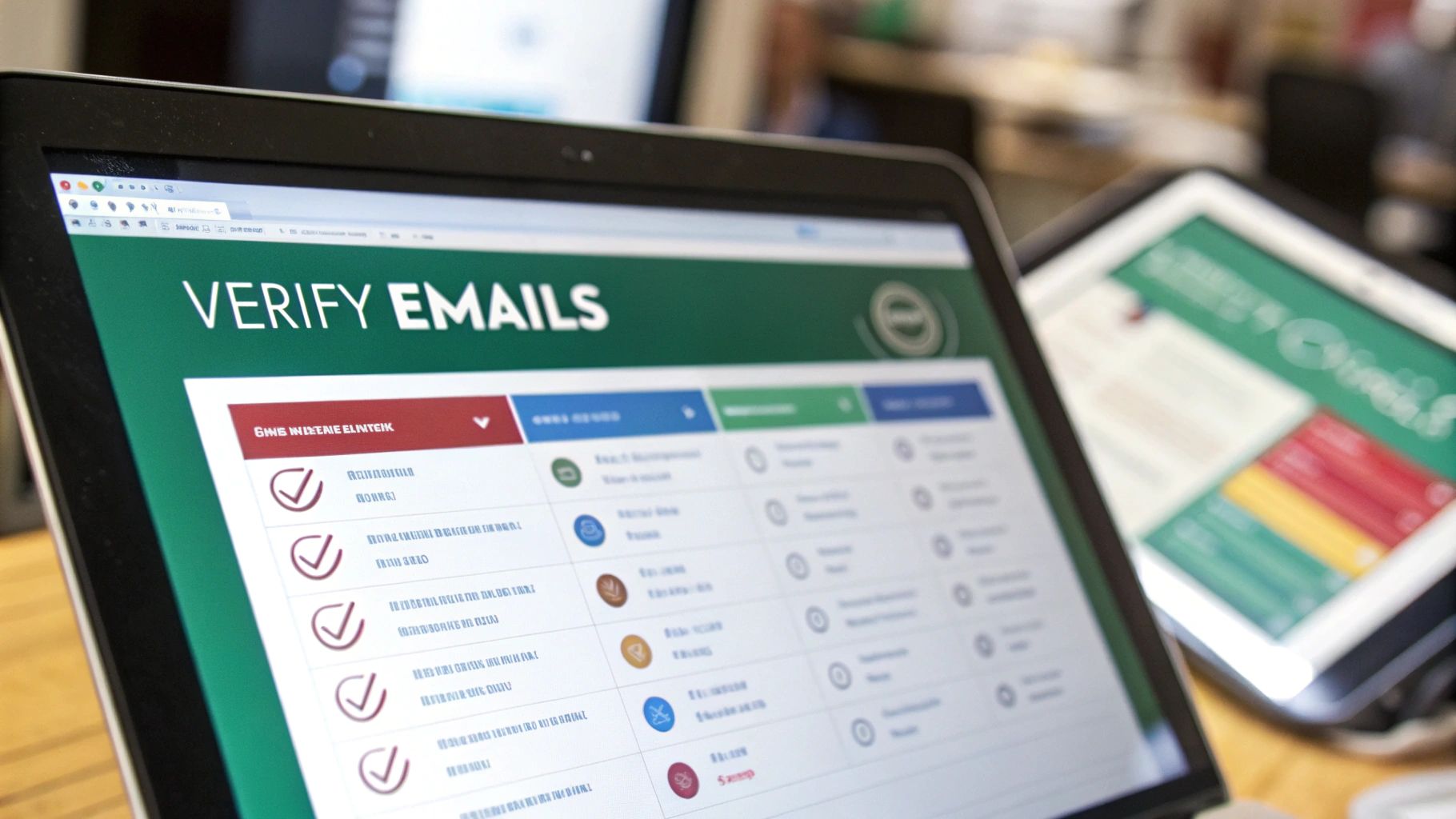
Finding what looks like a great email address is only the first step. The real work is making sure it's actually active and can receive your message. If you skip this, it's like designing the perfect flyer and then throwing it into an empty lot. It's more than just wasted effort—it can seriously damage your professional reputation.
When you send a message to a dead or fake address, you get a hard bounce. This is a permanent delivery failure, and Internet Service Providers (ISPs) like Google and Microsoft are always watching. If they notice your domain is constantly hitting dead ends, their spam filters will start getting suspicious of all your emails, even the ones going to legit contacts.
The Damage to Your Sender Reputation
Your sender reputation is basically a credit score for your email domain. Every hard bounce is a big red mark on your record. Once that score drops, your emails are far more likely to get buried in the spam folder, killing your open rates and tanking your entire outreach strategy.
This is exactly why email verification services are a must-have. These tools don’t just guess; they run a series of technical checks to confirm an email address is valid before you ever hit "send."
Here's what a good verifier typically looks for:
- Syntax Errors: Is the format right? It checks for the basic
name@domain.comstructure. - Domain Validity: Does the domain even exist, and is it configured to accept emails?
- Mailbox Existence: It carefully pings the server to see if that specific user mailbox is active.
By cleaning your list with a verification tool, you get rid of all the addresses that would have turned into damaging hard bounces.
Sending emails without verifying them first is a gamble you just can't afford to take. A clean list protects your sender score, boosts deliverability, and makes sure your hard work actually gets seen.
When to Verify Your Email Lists
Knowing when to verify is just as important as knowing how. Think of it as a mandatory quality check. With an estimated 3.4 billion fake phishing emails sent every single day, the internet is full of bad addresses. Verification helps you contact real people, not spoofed accounts, which protects your own data and reputation.
Here are the moments when you absolutely must run a verification check:
- Before Launching a Cold Outreach Campaign: This is the big one. Firing off a mass email to an unverified list is the fastest way to get your domain blacklisted.
- When Importing New Contacts: Don't pollute your CRM with junk data from the start. A clean import means your sales and marketing teams are working with accurate info.
- Periodically for Existing Lists: People change jobs, and their old work emails die. It's smart to clean your existing lists every few months to get rid of the dead weight.
At the end of the day, this whole process is about making sure your effort pays off. For a deeper dive into the best tools and methods, our complete guide on email address verification has everything you need to maintain a healthy and effective outreach strategy.
Staying Ethical with Your Outreach
Once you’ve nailed down someone’s email address, the game changes. Having a direct line to just about anyone is a powerful thing, but it also means you’ve got to be respectful, transparent, and play by the rules. If you misuse that access, you’re not just risking your reputation—you could land in legal hot water.
The guiding principle here is simple: add value, don't create noise. Every single email you send needs a legitimate purpose, whether you’re networking, making a sales inquiry, or proposing a collaboration. Just blasting out generic, unsolicited messages is spam, plain and simple. It's the fastest way to get your domain blacklisted.
Navigating the Legal Landscape
Two big players govern email outreach: GDPR in Europe and the CAN-SPAM Act in the United States. They have their differences, but they both aim to protect people from deceptive and unwanted emails. You don't need a law degree to get the gist.
Here's what they generally boil down to:
- Be Honest: Your "From" name, subject line, and the email itself can't be misleading.
- Identify Your Intent: If it’s an ad, you have to clearly state that it’s an advertisement.
- Share Your Location: You’re required to include a valid physical postal address for your business.
- Provide an Out: Every email must have a clear, easy way for people to unsubscribe. And you have to honor those requests fast.
Following these rules isn't just about dodging fines; it's about building trust. An ethical approach shows you respect the recipient's time and inbox, which makes them far more likely to actually engage with what you have to say.
Good Outreach vs. Bad Outreach
The line between a welcome message and an annoying one usually comes down to personalization and transparency. A little bit of homework goes a long way. It shows you're not just firing another template into the void.
Let's break it down with a real-world example.
The Spammy Approach (What to Avoid):
Subject: Quick Question
Hey,
I saw your company online and thought you'd be a perfect fit for our revolutionary platform that streamlines synergy. Do you have 15 minutes to chat this week?
This email is just lazy. It's impersonal, vague, and offers absolutely zero value. The recipient has no clue who you are, what you do, or why on earth they should care. It screams "automated blast sent to 10,000 people."
The Professional Approach (What to Aim For):
Subject: Loved your article on content marketing
Hi Jane,
My name is Alex, and I’m with EmailScout. I just read your latest blog post on content marketing trends for 2024 and found your insights on AI-driven analytics especially sharp.
I found your email through your author bio, as I thought you might be interested in how our tool helps marketers like you identify key influencers for collaboration.
No pressure at all, but if that sounds interesting, I’d be happy to share a brief case study.
Best,
Alex
See the difference? This version works. It’s personalized, transparent about how the email was found, and offers value without a pushy sales pitch. It acknowledges the recipient's expertise and opens the door for a real conversation—which is the whole point of effective, ethical outreach.
Common Questions About Finding Emails
When you first dive into finding emails, a few questions always pop up. It's totally normal. Most people are curious about the rules, the best tactics, and whether or not their methods will actually work. Let's clear the air on some of the most common queries I hear.
Getting these answers straight from the get-go helps make sure your outreach is both effective and on the right side of the law.
Is It Legal to Find and Use Someone's Email Address?
This is the big one, and the short answer is yes—finding a publicly listed professional email for legitimate business outreach is generally fine. But here's the crucial part: it’s not finding the email that’s regulated, it’s how you use it.
Laws like the CAN-SPAM Act in the U.S. and GDPR in Europe are all about the message itself. They don't stop you from discovering an email, but they do set clear rules for contacting people.
To stay compliant, your outreach needs to tick a few boxes:
- Your message can't be deceptive. Be honest about who you are and what you're offering.
- You must give people an easy, obvious way to opt out. No tricks.
- When someone asks to be unsubscribed, you have to honor that request—and fast.
So, the act of finding the email? Not the issue. The real responsibility kicks in when you hit "send." Your outreach has to be respectful and follow the legal standards.
What Is the Most Accurate Way to Find an Email?
After years of doing this, I can tell you that no single method is 100% perfect every time. But there's a two-step process that gets you as close as possible, and it’s what the pros rely on. The industry gold standard is combining a high-quality finder tool with a separate verification service.
First, you use a reputable email finder tool to track down the corporate email. These tools are smart—they scan massive databases and use clever algorithms to figure out the right email format for a company.
Then, you take that email and run it through a dedicated verification tool. This is the magic step. It confirms the mailbox is real, active, and can actually receive your message, which is a lifesaver for your bounce rate. This "find-then-verify" combo is easily the most reliable strategy out there.
The most accurate method isn't just about finding an email; it's about confirming you've found the right, active email. This simple combination of tools saves time and protects your sender reputation.
Can I Reliably Find Emails from Social Media Profiles?
Honestly, it’s a bit of a gamble. Some people will list their email right in their LinkedIn "Contact Info" or pop it in their Twitter bio, but most don't. If you're only looking at social profiles, you're going to miss out on a lot of contacts. It’s just not a reliable primary strategy.
Think of social media as more of a clue-gathering mission than a direct source. It's fantastic for confirming someone's current company, their exact job title, and their full name. Armed with that intel, you can then jump over to a specialized email finder tool and pinpoint their actual email address with way more accuracy.
Ready to stop guessing and start connecting? EmailScout gives you the power to find verified email addresses with just one click. Try EmailScout for free today and make your outreach smarter and more effective.

